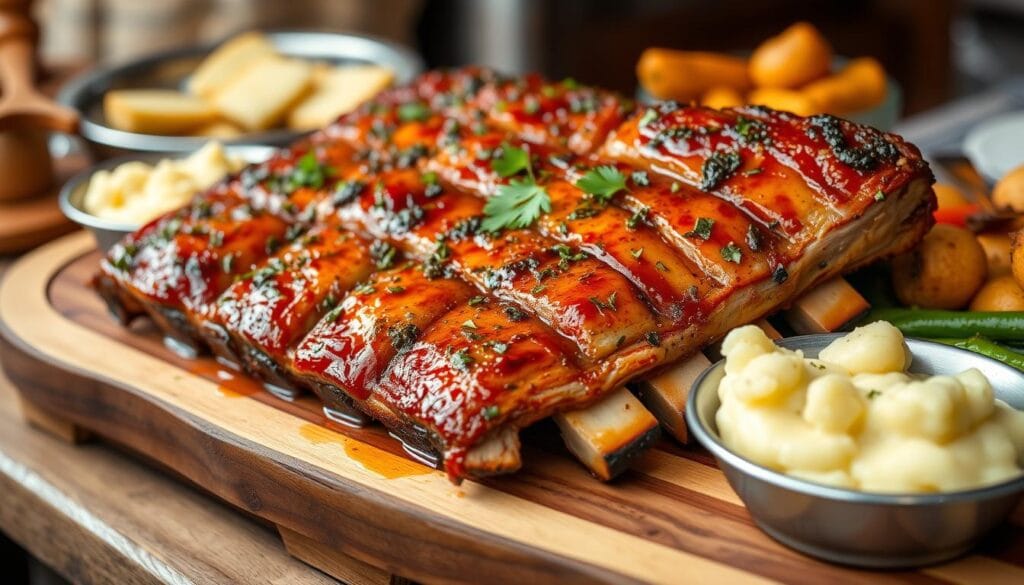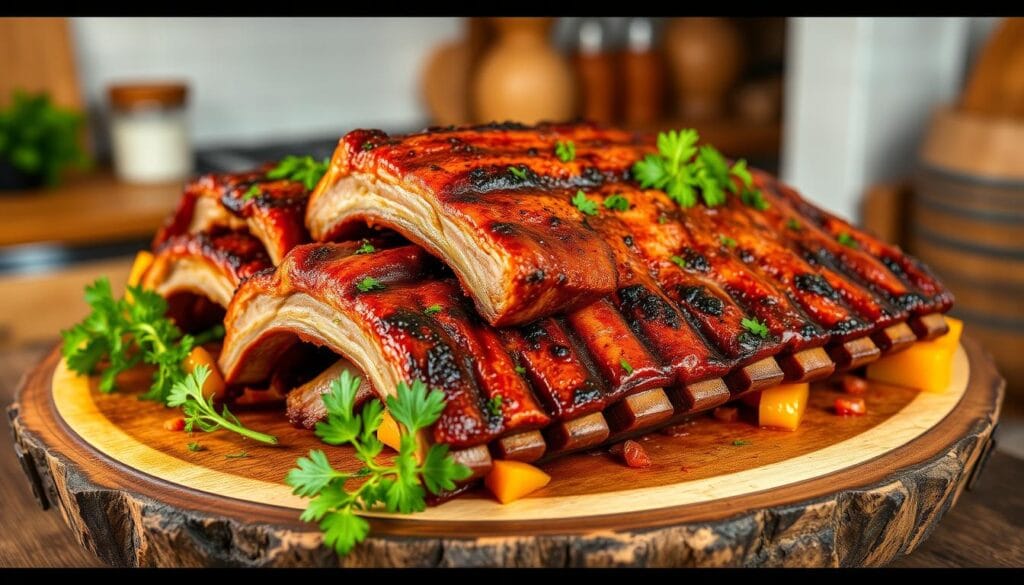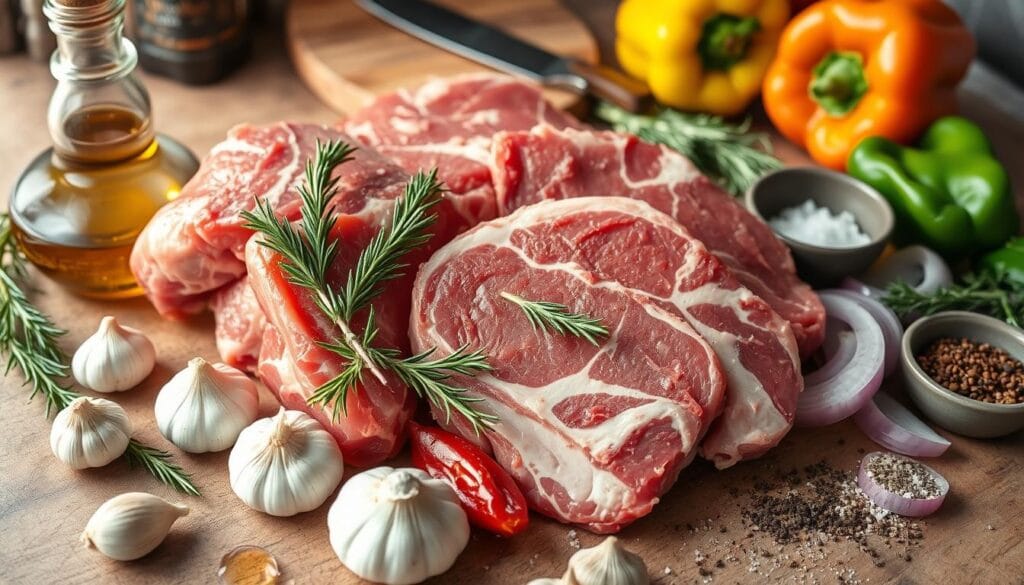
Are you ready to transform an ordinary dinner into a mouthwatering feast that will have everyone asking for seconds? Discover the ultimate country-style pork ribs recipe that promises maximum flavor in minimal time!
Our oven-baked ribs recipe delivers tender pork ribs with a spectacular homemade spice rub that will elevate your cooking game. Whether you’re a novice cook or a seasoned chef, this boneless pork ribs recipe will become your new go-to meal for impressive and delicious dining.
Key Takeaways
- Quick 35-minute preparation time for country-style pork ribs
- Versatile recipe suitable for 2-4 servings
- Customizable spice rub with household ingredients
- Optional BBQ sauce for enhanced flavor
- Safe internal cooking temperature of 145°F
- Easy storage options: refrigerate or freeze
- Highly rated recipe with 4.37/5 stars
Understanding Country-Style Boneless Pork Ribs
Pork cuts can be complex, especially when it comes to country-style ribs. These unique meat selections offer a delicious alternative to traditional rib preparations that many home cooks and barbecue enthusiasts appreciate.

What Are Country-Style Ribs
Country-style pork ribs are not actual ribs in the traditional sense. They originate from the shoulder area near the pork loin, creating a unique cut with exceptional flavor characteristics. Unlike typical ribs, these cuts are meatier and often sold as boneless or bone-in options.
- Sourced from the shoulder blade area
- Combination of lean and fatty meat
- More substantial than traditional rib cuts
- Excellent for various cooking methods
Different Cuts of Pork Explained
When exploring pork cuts, country-style ribs stand out for their versatility. These meat selections typically feature more marbling, which enhances flavor and tenderness during cooking.
| Cut Type | Fat Content | Cooking Method |
|---|---|---|
| Country-Style Ribs | High Marbling | Slow Cooking, Grilling |
| Spare Ribs | Moderate Marbling | Smoking, Barbecuing |
| Baby Back Ribs | Low Marbling | Oven Roasting |
Why Choose Boneless Over Bone-in Ribs
Boneless vs bone-in ribs presents an interesting culinary debate. Country-style boneless ribs offer distinct advantages for home cooks seeking convenience and consistent cooking results.
“Country-style ribs provide the perfect balance between flavor and ease of preparation.” – Culinary Expert
These ribs cook more evenly, require less trimming, and allow for easier portion control. Their higher fat content ensures juicy, tender meat when prepared correctly, making them an excellent choice for various recipes.
Essential Ingredients for Recipe for Pork Boneless Rib Meat Chunks
Creating delicious pork rib ingredients requires careful selection of high-quality components. The star of this recipe is 2 pounds of premium boneless pork ribs, perfect for crafting a mouthwatering main dish that serves 4 people.

Your pork rib meat chunks demand a robust spice rub that transforms ordinary meat into an extraordinary culinary experience. The key spices include:
- Paprika for rich color and depth
- Fine sea salt to enhance natural flavors
- Garlic powder for aromatic intensity
- Ground black pepper for subtle heat
- Dried oregano for herbal notes
- Cayenne pepper for optional kick
For the perfect finish, select a high-quality BBQ sauce that complements the meat’s natural richness. Opt for a sauce with balanced sweetness and tanginess.
| Ingredient | Quantity | Purpose |
|---|---|---|
| Boneless Pork Ribs | 2 pounds | Main protein |
| Vegetable Oil | 2 tablespoons | Searing meat |
| BBQ Sauce | 1/2 cup | Glazing and flavor |
Pro tip: The right combination of spice rub and BBQ sauce can elevate your pork rib meat chunks from good to unforgettable!
Each ingredient plays a crucial role in creating a memorable dish that will impress your dinner guests and satisfy hungry appetites.
Perfect Seasoning Blend and Spice Rub
Crafting the ultimate homemade spice rub transforms ordinary pork into an extraordinary culinary experience. A well-designed pork seasoning can elevate your dish from simple to spectacular, bringing depth and complexity to every bite.
Creating the Signature Spice Mix
The perfect pork seasoning blend combines a harmonious mix of flavors that tantalize the taste buds. Here’s a robust homemade spice rub recipe that will impress even the most discerning food enthusiasts:
- 3/4 cup dark brown sugar
- 2 tablespoons kosher salt
- 2 tablespoons smoked paprika
- 1 tablespoon dry mustard
- 1 tablespoon granulated garlic
- 1 teaspoon cayenne pepper
- 1 teaspoon allspice
- 1 tablespoon ground black pepper
Optional Flavor Enhancers
Elevate your flavor enhancers by experimenting with additional ingredients that complement the base spice mix:
- Ground cumin for earthiness
- Dried thyme for herbal notes
- Chipotle powder for smoky heat
- Red pepper flakes for extra kick
Marinade Options
Transform your dry rub into a wet marinade by combining the spice mix with:
- Olive oil
- Fresh lemon juice
- Worcestershire sauce
“The secret to great pork is in the seasoning – layer your flavors and let them shine!” – Professional Chef
Pro tip: Allow the spice rub to sit on the meat for at least 2 hours, or ideally overnight in the refrigerator, to maximize flavor absorption. Store your homemade spice rub in an airtight container for up to one year, ensuring maximum potency and taste.
Preparation and Trimming Techniques
Preparing boneless ribs requires careful attention to detail. Trimming pork ribs is a crucial step that can significantly improve the final dish’s quality and flavor. Professional chefs understand that proper preparation makes all the difference in creating mouthwatering meat.
When trimming pork ribs, focus on these key techniques:
- Remove excess surface fat
- Inspect meat for uneven sections
- Pat meat dry with paper towels
- Trim any tough connective tissues
“The secret to perfect ribs starts with meticulous preparation” – BBQ Experts
Preparing boneless ribs involves strategic fat removal. Cut away thick fat caps but leave a thin layer to enhance flavor and moisture. Use a sharp boning knife for precise trimming, ensuring even cuts that promote consistent cooking.
| Trimming Step | Purpose | Technique |
|---|---|---|
| Fat Removal | Reduce excess grease | Trim to 1/4 inch thickness |
| Surface Preparation | Enhance seasoning absorption | Pat completely dry |
| Tissue Management | Improve meat texture | Remove tough membranes |
Pro tip for trimming pork ribs: Always work on a clean cutting board and use gloves to maintain food safety. Take your time during preparation to ensure beautiful, restaurant-quality results.
Searing Methods for Maximum Flavor
Mastering the art of searing pork ribs can transform an ordinary meal into a culinary masterpiece. The right technique creates a delectable golden-brown crust that locks in incredible flavor and juiciness.
Achieving the perfect sear requires careful attention to detail and understanding of cooking techniques. Professional chefs know that browning meat is more than just applying heat – it’s a precise culinary skill.
Selecting the Ideal Cooking Surface
A cast iron skillet stands out as the ultimate tool for searing. Its superior heat retention and even distribution make it perfect for creating that sought-after caramelized exterior.
- Preheat the cast iron skillet until it’s smoking hot
- Use high smoke point oils like vegetable or peanut oil
- Pat meat dry before searing to ensure maximum browning
Temperature Control Techniques
Temperature management is crucial when searing pork ribs. The USDA recommends cooking pork to a safe internal temperature of 145°F (63°C), but achieving the perfect sear requires specific heat control.
| Meat Type | Recommended Searing Time | Target Internal Temperature |
|---|---|---|
| Boneless Pork Ribs | 3-5 minutes per side | 145°F (63°C) |
Achieving the Perfect Sear
The reverse searing method can elevate your cooking. Start by cooking the meat at a low temperature until it reaches about 30°F below your target, then finish with a high-heat sear to create that mouthwatering Maillard browning.
“Searing is not just cooking – it’s creating a flavor explosion with every bite.” – Culinary Expert
Pro tip: Don’t overcrowd the pan. Give each piece of meat enough space to brown properly, which ensures a crisp, flavorful crust without steaming.
Oven Temperature and Cooking Times Guide
Mastering the perfect oven-baked ribs requires understanding precise cooking temperature and timing. The key to tender, flavorful pork rib meat chunks lies in careful heat management and patience.
Different cooking approaches can yield exceptional results for your pork ribs. Let’s explore the optimal techniques for achieving mouth-watering tenderness.
Recommended Cooking Methods
- Conventional Oven Method: 375°F (190°C)
- Low and Slow Method: 275°F (135°C)
- Standard Baking Method: 350°F (175°C)
| Cooking Method | Temperature | Cooking Time | Internal Temp |
|---|---|---|---|
| Conventional Baking | 375°F | 25-30 minutes | 145°F |
| Low and Slow | 275°F | 2-2.5 hours | 170°F |
| Standard Method | 350°F | 1 hour 45 minutes | 160°F |
Pro tip: Always use a meat thermometer to ensure your pork rib meat chunks reach the safe internal temperature of 145°F for perfectly cooked ribs.
“The secret to great oven-baked ribs is patience and precise temperature control.” – Professional Chef
Remember that cooking times can vary based on the thickness of your pork ribs and your specific oven’s characteristics. Experiment with different methods to find your perfect technique for delicious, tender pork rib meat chunks.
BBQ Sauce Application and Glazing
Transforming your pork ribs from good to extraordinary requires mastering the art of BBQ sauce for ribs and glazing techniques. The right sauce can elevate the entire dining experience, creating a mouthwatering finish that will impress even the most discerning barbecue enthusiasts.
Choosing the Right BBQ Sauce
Selecting the perfect BBQ sauce is crucial for rib sauce application. A well-crafted sauce should complement the spice rub and enhance the meat’s natural flavors. Consider these key factors when choosing your sauce:
- Flavor profile that matches your spice rub
- Balanced sweetness and tanginess
- Consistency that allows for smooth glazing
Glazing Techniques for Perfect Pork Ribs
Glazing pork ribs requires precision and patience. Here’s a step-by-step approach to achieve a delectable caramelized exterior:
- Apply sauce during the last 15-20 minutes of cooking
- Brush generously on top and sides of the ribs
- Use a high heat method to set the glaze
“The secret to perfect ribs is in the glazing – it’s where magic happens!” – BBQ Pitmaster
| Glazing Stage | Temperature | Duration |
|---|---|---|
| Initial Sauce Application | 350°F | 15-20 minutes |
| Final Caramelization | Broil/High Heat | 4-5 minutes |
Pro tip: For an extra layer of flavor, consider creating a homemade BBQ sauce using six simple ingredients: ketchup, molasses (or brown sugar), cider vinegar, Worcestershire sauce, soy sauce, and hot sauce. This custom blend can be refrigerated for up to 3 months, ensuring you always have a delicious glaze on hand.
Testing for Doneness and Internal Temperature
Achieving the perfect pork rib doneness requires precision and the right tools. A meat thermometer is your most reliable companion in ensuring both safety and exceptional flavor. The USDA sets clear guidelines for safe pork temperature, but there’s an art to getting that perfectly tender result.
When checking pork rib doneness, you’ll want to focus on these key temperature ranges:
- Minimum safe temperature: 145°F
- Optimal tenderness: 195°F to 203°F
- Ideal fall-off-the-bone texture: Above 200°F
“The secret to perfect ribs lies in patience and precise temperature control.”
Different cuts of pork require slightly different approaches. Country-style ribs and spare ribs typically need longer cooking times to break down collagen and achieve maximum tenderness. Use a thin-needle meat thermometer with a 1/16 inch diameter for the most accurate readings.
Pro tips for checking pork rib doneness:
- Insert the thermometer into the thickest part of the meat
- Ensure the probe slides in easily
- Look for clean removal without resistance
Remember, the internal temperature determines not just safety but also the ultimate texture and flavor of your ribs.
Resting and Serving Suggestions
After cooking your delicious pork ribs, resting meat is a crucial step that transforms good barbecue into an exceptional meal. The resting process allows the juices to redistribute throughout the meat, ensuring each bite remains incredibly tender and flavorful.
When serving pork ribs, consider these classic side dishes that complement the rich, smoky flavors:
- Creamy coleslaw
- Sweet and tangy baked beans
- Buttery cornbread
- Zesty potato salad
- Roasted seasonal vegetables
Pro tip for resting meat: Allow your pork ribs to rest for 5-10 minutes after cooking. This critical period helps lock in moisture and ensures maximum tenderness.
| Serving Recommendation | Portion Size | Nutritional Insights |
|---|---|---|
| Ribs per Person | 2 ribs (½ pound) | Approximately 535 calories |
| Protein Content | 39g per serving | Supports muscle health |
| Storage Duration | 3-5 days refrigerated | Up to 6 months frozen |
“The secret to great barbecue isn’t just in the cooking, but in the resting and serving.” – BBQ Pitmaster
For those seeking lighter options, pair your side dishes for ribs with a fresh green salad or grilled vegetables to balance the meal’s richness.
Conclusion
This easy pork rib recipe transforms ordinary boneless pork ribs into a restaurant-quality meal that impresses every time. With simple techniques like precise searing and carefully controlled oven temperatures, anyone can create tender boneless ribs that rival professional barbecue establishments.
The versatility of this homemade BBQ ribs method allows for incredible customization. Whether you prefer a spicy rub, sweet barbecue sauce, or a more traditional flavor profile, these boneless pork ribs adapt beautifully to individual tastes. The recipe’s high rating of 4.91 out of 5 proves its consistent success with home cooks.
By following the step-by-step instructions outlined in this guide, you can confidently prepare a delicious meal that delivers exceptional flavor and texture. Remember to pay attention to internal temperature, resting time, and seasoning to ensure perfect results every single time.
From weeknight dinners to weekend gatherings, this pork rib recipe offers a delectable solution that will have your family and friends requesting seconds. Enjoy your culinary creation!
FAQ
What are country-style ribs?
Country-style ribs are actually cut from the pork shoulder area, not traditional rib sections. They’re meaty, well-marbled cuts shaped like ribs but technically from the shoulder blade end of the pork loin, offering more tenderness and easier eating compared to traditional spare ribs.
How long does it take to cook boneless pork ribs?
Cooking time varies depending on your method. For oven-baking, expect approximately 35-45 minutes at 325°F (165°C), or 2-2.5 hours at a lower temperature of 275°F (135°C) for fall-apart tender ribs.
What internal temperature should pork ribs reach?
The USDA recommends a minimum internal temperature of 145°F (63°C). However, for more tender results, aim for 170°F (77°C) to 190°F (88°C), which allows more fat to break down and creates more tender meat.
Can I use a different type of meat for this recipe?
While this recipe is specifically for pork country-style ribs, similar techniques can be applied to other cuts like chicken thighs or beef short ribs. Just adjust cooking times and temperatures accordingly.
How do I prevent my ribs from becoming dry?
To keep ribs moist, use a combination of techniques: sear at high heat, cover with foil during slow cooking, use a marinade or spice rub with oil, and avoid overcooking. Let the meat rest 5-10 minutes after cooking to redistribute juices.
What side dishes pair well with these ribs?
Classic BBQ sides like coleslaw, baked beans, cornbread, and potato salad complement these ribs perfectly. For a healthier option, consider roasted vegetables or a fresh green salad.
Can I prepare the ribs in advance?
Yes! You can marinate the ribs 2-4 hours before cooking, or even prepare them a day ahead and refrigerate. When ready to serve, bring to room temperature and then bake or reheat in the oven.
Do I need special equipment to make these ribs?
A cast-iron skillet or oven-safe pan is ideal for searing, and an instant-read meat thermometer helps ensure proper doneness. Otherwise, standard kitchen tools like a baking dish, measuring spoons, and mixing bowls will work fine.

